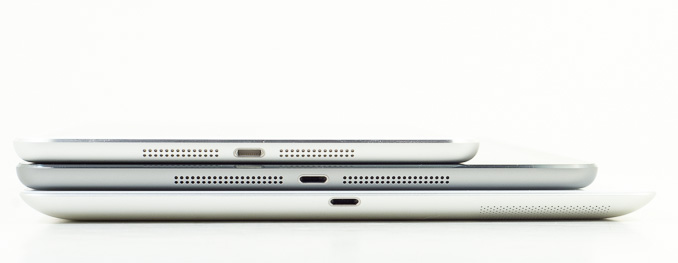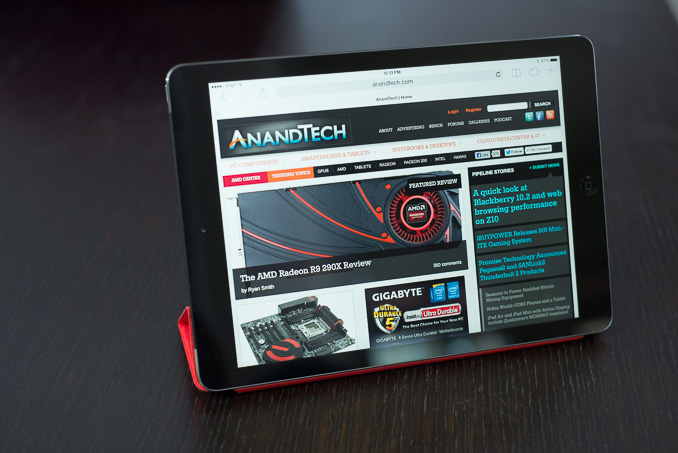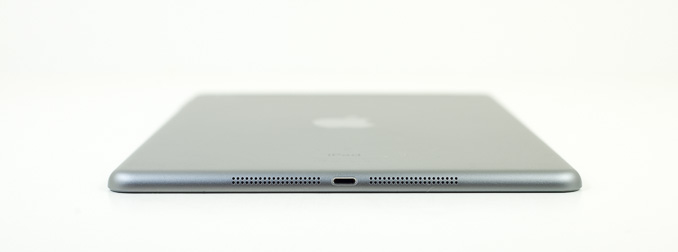The iPad Air Review
by Anand Lal Shimpi on October 29, 2013 9:00 PM ESTFinal Words
Two weeks ago I had all but written off the bigger iPad. It was too bulky and just no where near as portable as the iPad mini. Once the latter gets a Retina Display and equal hardware across the board, why would anyone consider the bigger model?
The iPad Air changed my perspective on all of that. It really does modernize the big iPad. While I suspect there are still going to be a lot of users who prefer the smaller form factor of the iPad mini with Retina Display, I do feel like there are those users who will continue to appreciate all of the benefits that go along with having a larger display. Text is easier to read, particularly on desktop versions of websites. Photos and videos are larger and thus more engaging as well. In the past there was this complex matrix of tradeoffs that you had to make between iPad and iPad mini. This generation, Apple does away with all of that.
All you need to do is pick your screen size. If you prefer the 9.7-inch form factor of the original iPad, the Air gets you as close as possible to a mini without giving up that display size.

From top to bottom: iPad mini, iPad Air, iPad 4
The name does the product justice in this case. In two hands or lightly propped up against something (palm, legs, chest), the iPad Air feels incredibly light - the weight just seems to disappear. The larger chassis doesn’t feel very dense at all. The in-hand feel of the device is really unlike any other iPad. It feels like a lightweight slate, rather than a heavy computing device. This is the iPad that Apple likely wanted to launch on day 1, it just took a bit over three years to get here.
Build and material quality are of course excellent. The iPad Air borrows much of the design language from the iPad mini, and makes the transition to a larger display quite nicely. The Air ends up looking a lot more modern than its predecessor.
Despite making the transition to a thinner touch and display stack, the iPad Air’s display is every bit as good as previous Retina Display iterations. Color accuracy remains best in class, delivering an out of box display experience that’s better than most systems, even at substantially higher price points. The only thing that the iPad Air leaves me wanting on the display front is a lower reflectance stack. Laminating the cover glass to the LCD panel is something that Apple does on both the iPhone and iMac, it’s time that the same feature is brought down to the iPad.
Apple’s decision to unify silicon across the iPhone 5s, iPad Air and iPad mini with Retina Display is an interesting one, but ultimately it doesn’t come with any real tradeoffs for iPad owners. Apple’s own 64-bit Cyclone cores are incredibly powerful, even more so than I originally expected when I reviewed the iPhone 5s. Apple seems to have built a bigger, higher performance CPU architecture than any other ARM player, including ARM itself. The design isn’t perfect, but it’s a completely different caliber performer than anything else it competes against. As such, Apple was completely justified in putting the A7 in both the iPhone 5s and the iPad Air. If anything, I’d argue that it might be overkill for the 5s given the device’s smaller battery, but my sensibilities soon get the best of me and remind me that more performance on tap is never a bad thing.
On the GPU front, Apple does increase performance over the iPad 4 as well - despite having a narrower memory bus. The increase in performance ranges from 40 - 70% depending on workload. I suspect we’re beginning to see some of the limits of 28nm here as Apple would’ve traditionally gone for an even larger GPU.
Despite having a smaller/thinner/lighter battery, battery life improves across the board compared to the 3rd and 4th generation iPads. Battery life in our web browsing, video playback and gaming workloads is better than either of the previous two iPads. Only the iPad 2,4 was able to deliver better battery life, but nothing with a Retina Display can match the iPad.
Cellular integration remains awesome on the iPad Air. With a single SKU covering 34 countries and no network operator lock, at least for those devices sold in the US, the LTE iPad Air is amazingly flexible from a network portability standpoint.
Improvements around the edges are nice as well. The inclusion of a second microphone can improve FaceTime HD calls in noisy environments, and faster WiFi is a nice addition.
My only complaints are limited to iOS 7, memory size and pricing. It’s clear that even on the fastest hardware Apple has to offer, iOS 7 isn’t always super smooth (particularly when using multitasking gestures to switch between apps) on an ultra high resolution device. The move to a 64-bit OS and applications makes a lot of sense, but with no corresponding increase in DRAM size Apple creates additional memory pressure on all of the A7 enabled devices. Finally, I’d love to see Apple update the default iPad configurations. Although 16GB is fine for a device that’s not going to be storing a ton of photos/videos locally, it would really be nice to get at least 32GB on the entry level iPad. The first complaint I suspect will be addressed over time. The second is a reality we just have to live with unfortunately, and the third won’t change until market dynamics force it to.
The iPad Air is the most significant upgrade to the 9.7-inch iPad in its history. It’s lighter, more portable, more usable and faster than any previous iPad. It doesn’t fundamentally change what you can do with a tablet, but if you’re in the market for one the iPad Air really is the best iPad to date. Competition is definitely more stiff among the smaller tablets thanks to the Nexus 7, but in the nearly 10-inch tablet space it seems like Apple is going to continue to enjoy a great position there.












444 Comments
View All Comments
michal1980 - Wednesday, October 30, 2013 - link
Did you read? I was talking about windows 8.1, you know the big upgrade given away 2 weeks agoI know that in iSheep land windows doesn't exist.
abazigal - Saturday, November 2, 2013 - link
He's probably writing it even as we speak, and it will likely be posted in a matter a time.Anand has a ton of devices to review, so they have to set a priority. Not to mention that he has pretty much stated that he works on an iMac, so I imagine using Win8 actually takes away from his productivity time.
algalli - Wednesday, October 30, 2013 - link
Your right Windows 8.1 will be used by tens of people not hundreds of millions of people, at least in the tablet worldjecastejon - Wednesday, October 30, 2013 - link
And by the same standard, objectiveness and evidences you present I say you are paid by Apples's competitors.darwiniandude - Wednesday, October 30, 2013 - link
Really?? Strange... The detailed review I just read complained (politely) about Apple not letting them dissect (cut open) review (loan) units. It also mentioned GUI performance frame rate drops in the multitasking UI and complained that due to 64bit they really need to ship with 2GB ram rather than the 1GB they come with. I can guarantee most other reviews out there will not mention these particular technical negatives. Anandtech reviews are thorough.Rickschwar - Thursday, October 31, 2013 - link
Although I haven't seen too much Apple bias from AnandTech in the past, this is one of the most biased reviews I have ever read. This is surprising because normally AnandTech is the “gold standard” for all things technical. The reviewer talks about the iPad Air like it’s a revolutionary product, when there is little new about it. Apple was playing catch up in many ways and other tablets have many advantages over it. For example, the iPad 4 was thicker than many Android tablets. In fact, at least ten Android tablets were thinner than the iPad 4. The Air is only 1.9 mm thinner than the iPad 4 and tablets like the older Sony Experia Z are still significantly thinner than the iPad Air is (7.5mm vs. 6.9mm). Of course this wasn't mentioned in the article. Even when it comes to weight, the iPad Air isn’t dramatically lighter than the Experia Z (469g vs. 495g). That’s not mentioned in the article either.Since I’m in the market for a new tablet and I’ve owned two iPads in the past, I was hoping for big things with the new iPad, but for me and others it was a “meh” release. The same old display, the same A7 processor, and little real innovation. CNET agrees saying “Functionally, the iPad Air is nearly identical to last year’s model, offering only faster performance and better video chatting.”
The most ironic part for my is the fact than more 90% of this article is based on benchmarks -- even though AnandTech has made it clear how easy it is to game benchmarks and others (including an article I wrote over a year ago published at Mostly-tech.com) have made compelling cases that benchmarks do not predict real world performance. This article mostly ignores real world performance and pretends that Android tablets don’t exist.
After this article I will never look at AnandTech the same again. At least the CNET and Engadget reviews covered some of the limitations of this product.
- Rick
abazigal - Saturday, November 2, 2013 - link
The ironic thing about your statement is that for the moment at least, only Android OEMs have been found guilty of gaming benchmarks, not Apple. So doing any benchmark tests at this juncture would actually favour Apple's competitors, despite this being a review of an Apple product. So I don't see what reason you have to complain, when the odds are stacked in Android's favour anyways.Besides, Anand has thoroughly dissected the A7 chip in his 5s review, and concluded that it is actually faster and more power-efficient compared to the higher-clocked, quad-core processors found in Android phones and tablets. The fact remains that Android and most mobile apps generally aren't optimised with 4-cores in mind either. So for all intents and purposes, Android tablets may as well not exist, since they will likely lose to the iPad in terms of real-world performance anyways.
Also, the thing with these products is that they are ultimately a package deal. People don't just look at 1 single defining factor and buy a device based solely on that. Likewise, I am definitely not going to blindly buy the thinnest tablet in the market without first considering other factors like specs and availability of apps. You are not going to find that mythical Android tablet which is thinner, lighter, has a longer battery life, better screen, while boasting a larger market of apps and content.
I am sorry, but you are not going to find a more objective and detailed review anywhere else. You want the iPad air to be bashed, go hand out at some pro-android forum instead.
ADGrant - Saturday, November 2, 2013 - link
"Same old A7 processor". You look like a complete idiot when you post something like that. The A7 was announced less than a month ago.sunflowerfly - Thursday, October 31, 2013 - link
Anand biased? I do not believe that. They have no trouble pointing out Apple's flaws, and every product has them, nothing is perfect. The best products should win, and right now that happens to be Apple a lot of the time.ssiu - Tuesday, October 29, 2013 - link
No 2GB RAM; hope dashed :(Does that mean an iPad 4 (which can only run 32-bit code) will end up "less RAM starved" than iPad Air running 64-bit code?